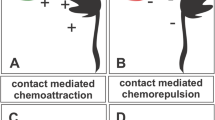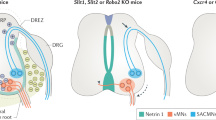Abstract
During development, neurons extend axons to their targets, then become dependent for their survival on trophic substances secreted by their target cells. Competition for limiting amounts of these substances is thought to account for much of the extensive naturally-occurring cell death that is seen throughout the nervous system. Here we show that spinal commissural neurons, a group of long projection neurons in the central nervous system (CNS), are also dependent for their survival on trophic support from one of their intermediate targets, the floor plate of the spinal cord. This dependence occurs during a several-day-long period when their axons extend along the floor plate, following which they develop additional trophic requirements. A dependence of neurons on trophic support derived en passant from their intermediate axonal targets provides a mechanism for rapidly eliminating misprojecting neurons, which may help to prevent the formation of aberrant neuronal circuits during the development of the nervous system.






Similar content being viewed by others
References
Oppenheim,R. W. Neurotrophic survival molecules for motoneurons: an embarrassment of riches. Neuron 17, 195–197 (1996).
Pettmann,B. & Henderson,C. E. Neuronal cell death. Neuron 20, 633–647 (1998).
Altman,J. & Bayer,S. A. The development of the rat spinal cord. Adv. Anat. Embryol. Cell Biol. 85, 1–164 (1984).
Tessier-Lavigne,M., Placzek,M., Lumsden,A. G., Dodd,J. & Jessell,T. M. Chemotropic guidance of developing axons in the mammalian central nervous system. Nature 336, 775–778 (1988).
Placzek,M., Tessier-Lavigne,M., Jessell,T. & Dodd,J. Orientation of commissural axons in vitro in response to a floor plate-derived chemoattractant. Development 110, 19–30 (1990).
Kennedy,T. E., Serafini,T., de la Torre,J. R. & Tessier-Lavigne,M. Netrins are diffusible chemotropic factors for commissural axons in the embryonic spinal cord. Cell 78, 425–435 (1994).
Serafini,T. et al. The netrins define a family of axon outgrowth-promoting proteins homologous to C. elegans UNC-6 Cell 78, 409–424 (1994).
Serafini,T. et al. Netrin-1 is required for commissural axon guidance in the developing vertebrate nervous system. Cell 87, 1001–1014 (1996).
Keino-Masu,K. et al. Deleted in Colorectal Cancer (DCC) encodes a netrin receptor. Cell 87, 175–185 (1996).
Compenot,R. B. Development of sympathetic neurons in compartmentalized culture. I. Local control of neurite growth by nerve growth factor. Dev. Biol. 93, 1–12 (1982).
Cowan,W. in Symposia Celebrating the Harvard Medical School Bicentennial (ed. Isselbacher, K.) 643–688 (Wiley, New York, 1984).
Davies,A. M. Neurotrophin switching: where does it stand? Curr. Opin. Neurobiol. 7, 110–118 (1997).
Buchman,V. & Davies,A. Different neurotrophins are expressed and act in a developmental sequence to promote the survival of embryonic sensory neurons. Development 118, 989–1001 (1993).
Wright,E., Vogel,V. K. & Davies,A. Neurotrophic factors promote the maturation of developing sensory neurons before they become dependent on these factors for survival. Neuron 9, 139–150 (1992).
Farinas,I., Yoshida,C., Backus,C. & Reichardt,L. Lack of neurotrophin-3 results in death of spinal sensory neurons and premature differentiation of their precursors. Neuron 17, 1065–1078 (1996).
Liebl,D., Tessarollo,L., Palko,M. & Parada,L. Absence of sensory neurons before target innervation in brain-derived neurotrophic factor, neurotrophin-3 and tTrkC-deficient embryonic mice. J. Neurosci. 17, 9113–9121 (1997).
Wilkinson,G. A., Farinas,I., Backus,C., Yoshida,C. K. & Reichardt,L. F. Neurotrophin-3 is a survival factor in vivo for early mouse trigeminal neurons. J. Neurosci. 16, 7661–7669 (1996).
Pinon,L., Minichiello,L., Klein,R. & Davies,A. Timing of neuronal death in trkA, trkB and trkC mutant embryos reveals developmental changes in sensory neuron dependence on Trk signalling. Neuron 122, 3255–3261 (1996).
Huang,E. et al. Expression of Trk receptors in the developing mouse trigeminal ganglion: in vivo evidence for NT-3 activation TrkA and TrkB in addition to TrKC. Development 126, 2191–2203 (1999).
Purves,D. & Lichtman,J. W. Principles of Neural Development (Sinauer, Sunderland, Massachusetts, 1985).
Meyer-Franke,A. Kaplan,M., Pfrieger,F. & Barres,B. Characterization of the signaling interactions that promote the survival and growth of developing retinal ganglion cells in culture. Neuron 15, 805–819 (1995).
Acknowledgements
We thank B. Barres for providing most of the factors tested, Amgen for the Steel Factor, D. Greenspan for BMP-1 protein, and R. O'Connor, J. Flanagan, M. W. Cowan, L. Reichardt, K. Brose, M. Galko and P. Leighton for helpful discussions and/or comments on the manuscript. Supported by a fellowship from the American Cancer Society to H.W. and by a grant from the National Institutes of Health to M.T.-L. M.T.-L. is an Investigator of the Howard Hughes Medical Institute.
Author information
Authors and Affiliations
Corresponding author
Rights and permissions
About this article
Cite this article
Wang, H., Tessier-Lavigne, M. En passant neurotrophic action of an intermediate axonal target in the developing mammalian CNS. Nature 401, 765–769 (1999). https://doi.org/10.1038/44521
Received:
Accepted:
Issue Date:
DOI: https://doi.org/10.1038/44521
- Springer Nature Limited
This article is cited by
-
RETRACTED ARTICLE: APP binds DR6 to trigger axon pruning and neuron death via distinct caspases
Nature (2009)
-
Transient cell–cell interactions in neural circuit formation
Nature Reviews Neuroscience (2009)
-
Interactions with identified muscle cells break motoneuron equivalence in embryonic zebrafish
Nature Neuroscience (2001)
-
Molecular genetics of cranial nerve development in mouse
Nature Reviews Neuroscience (2001)
-
Stepping stone to death
Nature Neuroscience (2001)





